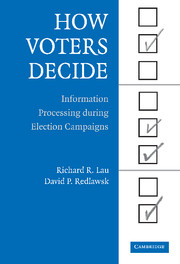Book contents
- Frontmatter
- Contents
- List of Tables and Figures
- Acknowledgments
- HOW VOTERS DECIDE
- I Theory and Methods
- II Information Processing
- 5 What Voters Do – A First Cut
- 6 Individual Differences in Information Processing
- 7 Campaign Effects on Information Processing
- III Politics
- IV Conclusion
- Appendix A Detailed Examples of Decision Strategies in Action
- Appendix B How the Dynamic Information Board Works
- Appendix C Overview of Experimental Procedures
- Appendix D Detailed Decision Scripts
- Appendix E Calculating the On-line Evaluation Counter
- References
- Index
- Titles in the series
6 - Individual Differences in Information Processing
Published online by Cambridge University Press: 05 September 2012
- Frontmatter
- Contents
- List of Tables and Figures
- Acknowledgments
- HOW VOTERS DECIDE
- I Theory and Methods
- II Information Processing
- 5 What Voters Do – A First Cut
- 6 Individual Differences in Information Processing
- 7 Campaign Effects on Information Processing
- III Politics
- IV Conclusion
- Appendix A Detailed Examples of Decision Strategies in Action
- Appendix B How the Dynamic Information Board Works
- Appendix C Overview of Experimental Procedures
- Appendix D Detailed Decision Scripts
- Appendix E Calculating the On-line Evaluation Counter
- References
- Index
- Titles in the series
Summary
The previous chapter presented, with moderately broad brush strokes, the decision processes people used in trying to make their vote choices in our mock presidential election. In that initial presentation of our data, we ignored, for the most part, differences between voters, differences among candidates, and (with the major exception of presenting information from the primary and general election campaigns separately) differences across campaigns. But all voters are not the same, candidates oftentimes do have very significant differences, and campaigns – even limiting consideration to presidential campaigns – come in many different flavors. More importantly, theory tells us that certain variations among decision makers (i.e., voters), alternatives (candidates), and decision contexts (campaigns) are particularly interesting to examine. Of course, that same theory guided the design of our research in the first place in that it suggested interesting experimental factors to manipulate and important individual difference variables to measure.
In this chapter and the next, we will provide much more focused explorations of our data. First we consider individual differences among decision makers. We will look in particular at three categories of individual differences: basic background demographic characteristics (including age, education, and gender), political sophistication or expertise, and two presumably long-standing political preferences – partisanship and ideology. The goal in these two chapters is still to understand information processing, decision strategies, and memory – the crucial intervening variables in our model.
- Type
- Chapter
- Information
- How Voters DecideInformation Processing in Election Campaigns, pp. 119 - 134Publisher: Cambridge University PressPrint publication year: 2006



